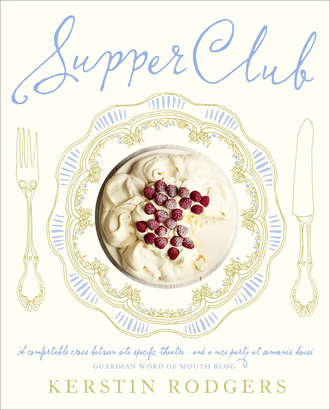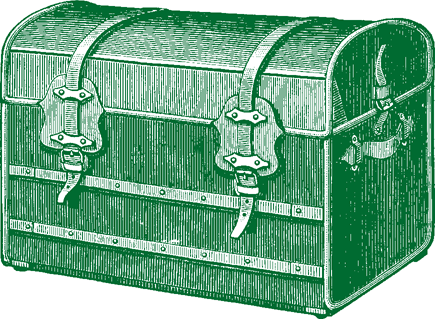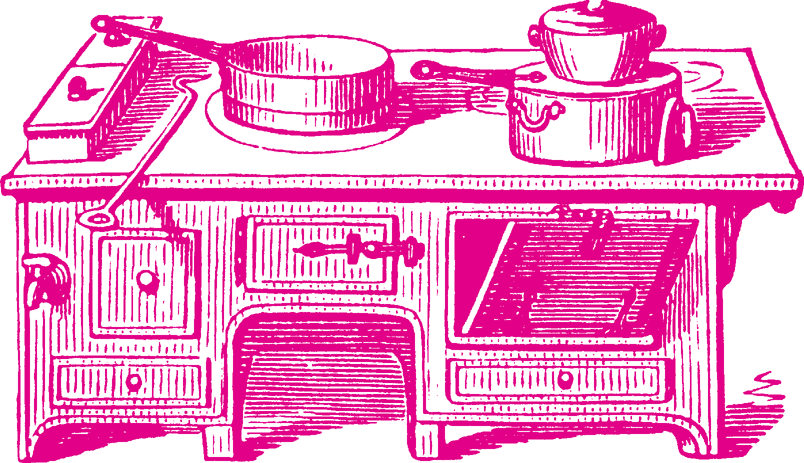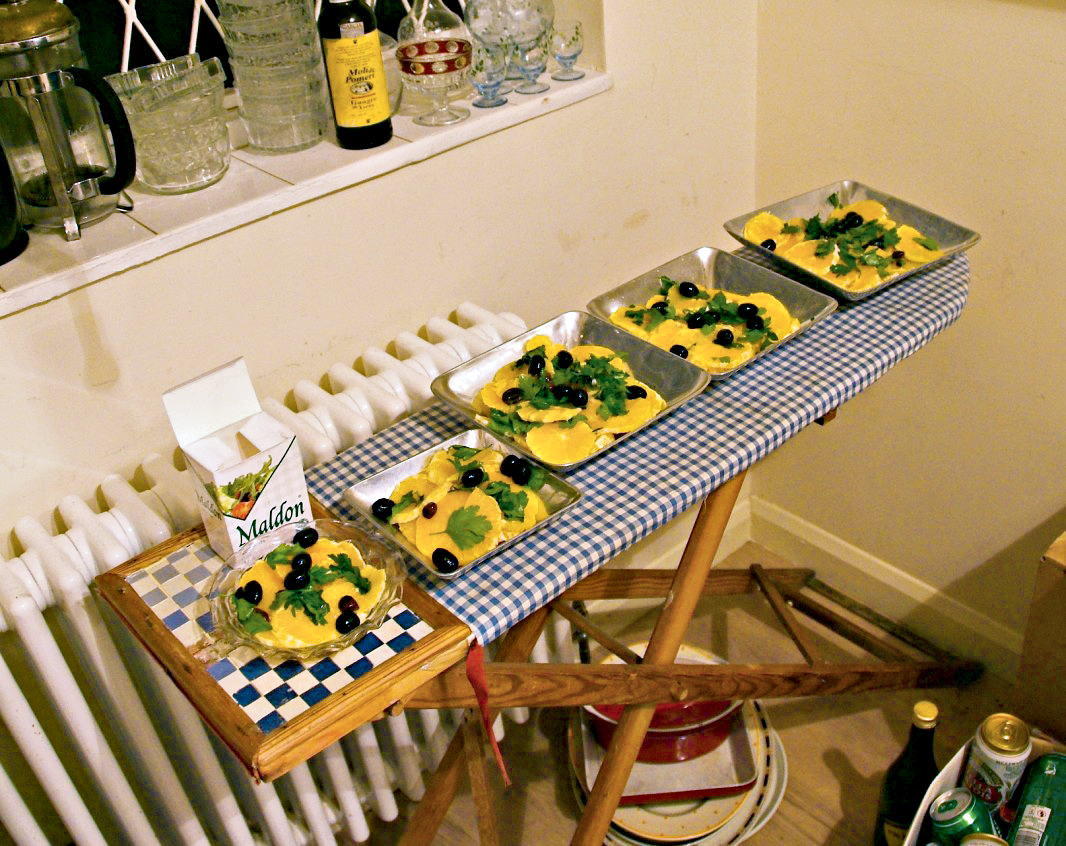
Полная версия
Supper Club: Recipes and notes from the underground restaurant
There are plenty of locations to host pop-up restaurants: ask for the use of a café that is open only at lunchtimes and would be happy to get a little rent for the evenings, or one that is normally closed at weekends. Do a deal with a pub, ask to use their function room while they provide the drink. This would avoid licensing problems. Other ideas for locations: an art gallery, a squat, a loft, a boat, a factory, a garden or allotment if the weather is good.
Personally I prefer it in the home. Part of the excitement is the voyeurism of going into someone’s private space. I love looking at people’s houses.
It’s true however that this takes a certain amount of bravery; where you live, how you live, your cooking, perhaps even your family life, is exposed to public view and possibly public criticism. But, people are aware of that and are always – so far, in any case – very polite. To your face at least. Who knows what they say on the car ride home? But they don’t expect restaurant-level cooking and a spotless, luxury location. The kind of people who book will be adventurous, curious and flexible. They just want something authentic and some proper home cooking.
So, banishing any insecurities, think about your space, where you live, where people are going to eat. Play to its strengths...do you have a big balcony or garden? Have the drinks on the balcony, or use it for barbecue cooking. Is there something quirky or unusual about the design of your place? Do you have a large or particularly nice kitchen? Make sure you invite people to have a look.

Where are people going to eat? The likelihood is that your living room is the largest room. I had to move first one, then the other sofa into my bedroom, then the TV, then everything else. My bedroom, formerly a luxury boudoir, designed to ensnare men, now looks like a junkshop.

The look: part of the charm of a supper club is your personal style...whatever it may be. I lived for six years in Paris and one year in Provence (a cliché, but true) and I’ve been collecting vintage crockery and French kitchenalia for years, so that is part of my style, shabby chic Francophilia.
You may prefer a more modern and clean look. A friend of mine, originally from Zimbabwe, has only wooden crockery and bowls, much of it African. Her flat is like going into a little forest, full of birds’ nests and chunks of tree trunk.
If you haven’t got much money, you might go to Ikea, or your local second-hand and charity shops. Freecycle and eBay are also options for free/cheap furniture and crockery. I’ve been to squats where you drink out of jam jars rather than glasses, it was fun!
It’s about vaunting your style…you may love heavy, hand-made pottery, slate platters, silver cloches or Toby Jugs. Even if you have no style or very bad taste, that too can be part of the experience. If you are in a large city and there are several supper clubs, you will find that people will do the circuit, come around to see you all, and they want each one to be different.
The individuality of the place and the table settings is part of the appeal. The quirkiness, the individuality, the absence of corporate tableware, all this is key to the success of a home restaurant.
There are some supper clubs that imitate restaurants. You book a table for two, you don’t talk to other tables. You have imitation restaurant food. The portions are tiny, nouvelle-cuisine restaurant stylee. You aren’t invited into the kitchen and all signs of slovenly family life have been tucked away. The service is formal, even obsequious. The china matches, and has been bought especially for the occasion.

I don’t get it. This is our chance to muck about with the format. Frankly, if I feel like serving a dozen starters and no pud, or vice versa, well why not? Let’s play. Yes, one has to give some food, there has to be some kind of chef/dinner/guest equation, but let’s push it around a little. ‘Guests’ can help out, come into the kitchen, get their own water. They keep their cutlery between courses, just like in France. ‘Staff’ can sit down and chat. The hierarchy is horizontal. It’s anarchy, but in the true sense of the word: ‘an’ (Greek for ‘without’) ‘archy’ (a ruler). Not chaos.
Remember: you are not a proper restaurant; you don’t have to pretend to be one. At first you will probably try to ape a restaurant – after all, this is the model that we know. But afterwards, as you gain confidence, tear up the rulebook!
Work out how many tables and chairs you have. Borrow from neighbours and relatives. (I went to one supper club that was allowed to borrow neighbour’s chairs only until midnight! Like Cinderella we had to sit on the floor afterwards!) You could also buy some cheap fold-down ones, depending on the look you want. You can always paint them, add nice cushions. Chairs, crockery, glasses and cutlery do not have to match: mismatching is great if everything ‘shouts’ at the same volume.

If you don’t have enough chairs, and the guests live nearby or have a car, let them bring their own. (Two girls once brought their own chairs to my place, then went out partying later, carrying them to a nightclub. They told me it was very handy for sitting down in the club later, not to mention a great conversation starter.) I have also used piano stools, drum stools, boxes, dressing-table stools.

The tables you buy, borrow or retrieve from the garden will guide whether you put your guests on small tables with separate parties or large mixed tables.
As for the bathroom, label it and signpost it so that people know where to go. Make sure it’s clean. Always have enough loo paper. A clean towel to dry their hands is good. After several weeks during which I kept having to buy more ear buds, I realised they were being used by the guests! I think conventional restaurants are missing a trick by not providing them! You could really go to town and provide eau de cologne, hairspray and lipstick as they do in the bathrooms of New York nightclubs.
5 FOOD.........................
Obviously this is the most important element. The menu is at the heart of what you are creating.

WHAT ARE YOU GOING TO COOK?.........................
The first few times, I’d stick to the dishes you are most comfortable with cooking. You will be nervous enough, you don’t want to cock up the cooking! Later on, you can let rip with the molecular experiments!
Leave enough time to prep, and for mistakes. In your anxious state, it’s amazing how dishes you’ve cooked perfectly a hundred times can go wrong. If you do decide to experiment, practise it first. Also remember that a dish that works wonderfully for 2–6 people is very different when you are doing it for double or more than that amount of people.
The secret of good food is: spend less time cooking and more time shopping! Unusual and seasonal ingredients, even just to garnish, can add that extra flair. This is what I do, but how you do it is up to you.
~ Cocktail with olives, pretzels or nuts ~
~ Starter ~
~ Home-made bread ~
~ Main course ~
~ Salad ~
~ Cheeseboard ~
~ Dessert ~
~ Coffee ~
(sometimes fresh mint tea, depending on the meal)

For £40 that’s not bad value. The point is, you can afford the whole experience. In conventional restaurants, a lot of mental arithmetic is involved, trying to figure out if you should share a starter, miss out pudding, have coffee at home. Those little bits really add up and that is how normal restaurants make their money, with the drink, the desserts and the coffees…in short, the extras. It can make dining a frustrating experience. Even when restaurants do fixed menus, frequently there are ‘supplements’ that are added on, generally for the dish you really want.
Other times I have done tapas or meze, up to 12 small courses.
SUPPLIERS AND INGREDIENTS.........................
So you’ve made a shopping list. But how much to buy? Another difficulty. In a conventional restaurant, what you don’t sell one night, you can sell the next. For an occasional supper club you have to get it right. Only experience can tell you that.

And where are you going to buy, say, 30 artichokes for your starters? They cost a fortune in the supermarket. Suppliers are the bane of most restaurants. Reliable suppliers are the most important element of any business. If you do have connections to professional chefs or kitchens, ask them who their suppliers are...and whether they mind adding on an order for you. You will get better deals and normally they deliver to your doorstep. That’s a huge relief when prepping can take up so much time, and you don’t want to be popping out to the shops every 5 minutes.
My local organic vegetable box scheme guy came to a dinner. He loved the concept and will now do me bulk prices. It does take a while to build these relationships but they are invaluable. Repay favours in kind, invite them to a dinner!

I do a mix of shopping between the local organic veg supplier and my local street markets. Going to a street market can be very inspirational when you are feeling a bit flat, a bit ‘What the hell shall I cook this week?’
Use good ingredients. Don’t skimp on quality. If your ingredients are good, you can’t go too far wrong. One supper club I read about didn’t cook anything. They just ordered great cheeses, hams, salamis, bread, salads, chutneys, smoked fish and set it out picnic-style.
If you or your friends have gardens or allotments, ask them to sell you their excess.
I do buy from large multi-national supermarkets sometimes. It’s convenient and they deliver, saving time for you. But I try not to do so. I feel this whole ‘movement’ is about circumventing large-scale corporations.
PLAN YOUR MENU.........................
Decide what kind of food, how many courses. When you know how many people you have coming, multiply whatever recipe you are doing to make that number of servings. Make a little extra. Many home restaurants do serve seconds, just like your mum would. Better to have more than less.

Think about your equipment in the context of your menu. Remember you have only a domestic kitchen. Plan your menu around your oven/cooker/fridge capacity. If you are doing three courses, have your menu balanced around hot and cold dishes. This relieves the pressure on your oven. So think it through. Maybe you want to start with a soup that can be made on the hob, a main that can be baked in the oven and a cold pudding.
A soup can also be prepared in advance and set aside; the salad won’t use up precious oven or hob space. Dessert can also be pre-prepped, made the day before.
Then prep. For your first meals, depending on how many people you have, give yourself two days. Make a ‘countdown’ of timings, what needs to be done first until last, and tick off tasks as you complete them. Obviously prep the stuff that stays less fresh last. Maybe part-cook some dishes and finish them off on the night.
Word of advice: don’t do pasta, unless it is baked, for more than eight people. It’s too hard to make it al dente for any more than that.
Yes, the food is important, but if they just want good food they can go to a conventional restaurant. What is essential is attention to detail, character, personality, intimacy, personal touches and…humour! You are really going to need that.
PORTION CONTROL.........................

This can be really hard to work out. Serve some dishes family-style. That is: a big plate in the middle for people to share. People love that, it encourages conversation.
Dishes that are plated-up obviously need to be more or less equal portions. I normally do this by eye, but you can also weigh them. Use one of those nifty digital scales on the counter and weigh each portion before putting it on a plate. This does slow things down but can be useful.

I always overestimate how much people want to eat. I have a morbid fear of people going home hungry, feeling ripped off. Once, a helper sent out very small portions of a starter. I took over and the rest of the starters were more generous. I didn’t know how to handle the situation with the poor diners that only had tiny portions, I was too embarrassed to take the plates back and put more food on them. Now I would go up to the diners and say that was a mistake, give me your plates back and I’ll put on some more! An underground restaurant doesn’t have to be a seamless operation. Mistakes are ok, they are even funny.
For plating up, you need a lot of counter space. If you haven’t got much space, use an ironing board, which is a nice long stretch to add to your counter length (make sure it’s steady), or even the floor if necessary. I’ve kept dishes needed for later covered on the floor in a corner.
Warm the plates if you can. I use an Aga and so I have the simmering oven for this, but you can also use the bottom of a conventional oven. This will keep the food warmer for longer, which is important if you have several tables. You don’t want the last few tables to get cold food.
Another trick about plating up is to have the plates that are ready to go out nearest to the door. It’s obvious I know, but it took me weeks to work that one out! In the panic, I often ended up doing it the wrong way around and the front-of-house would have to go around me to grab the plates.
SLOW FOOD.........................
I don’t ‘turn tables’. I believe in taking time over your food. I like a restaurant where you feel you could stay all night if you wanted. The table is yours for the night, as long as you want (within reason, although I have had people stay the night when they are too drunk to make their way home).

Send food out with short intervals, say 20–30 minutes between courses. In a normal restaurant it’s usually 15 minutes between courses, but there they want the table back. On the one hand you don’t want to rush people, on the other, you don’t want them sitting there twiddling their thumbs. The front-of-house should be able to gauge and tell the cook when people are ready for their next course, when their plates are empty and they are starting to get restless.
Now, this being a home restaurant and not necessarily a slick machine, sometimes there will be delays. Sometimes there’s pressure: one thing after another goes wrong. It can be true ‘seat of your pants’ stuff, guerrilla cookery, and there have been moments when I worried that I’d have to order take-out for all my guests. One supper-club host told guests that dessert had gone wrong and so they were all getting a packet of chocolate buttons each. Did the trick, people laughed, and who doesn’t like chocolate buttons?

If the delay becomes obvious, then ’fess up, go out there and say ‘Sorry, waiting for the food to cook.’ Most people are understanding. If the delay is really bad, you could swap courses, serve something that’s ready, the salad, say. As a last resort you could get your front-of-house to go around with a bottle of wine, fill their glasses. Be open and humble about your mistakes, and all will be forgiven.
6 FRONT-OF-HOUSE.........................

If you haven’t got a partner in crime, then get help, ask for volunteers. Crazy it might sound, but people want to work for you for free! People love to join in and if you are a good cook, it’s like a free cooking lesson for your volunteer. It is also more companionable to have someone to bounce your ideas/mistakes off!
Typical conversation:
‘Not quite sure about this sauce/bread/dish. Think I’ll get away with it?’
Volunteer tastes.
‘Yeah. I like it. Maybe cut off the crack/funny colour/burnt bit, or cover with cream/bit of parsley/sauce.’
I also tell my ‘staff’, ‘Don’t take any shit from the guests. Be nice of course, but you are not a servant, you are not at their beck and call.’
In a home restaurant, the customer is not always right: I am.
Don’t have too many people in the kitchen. It confuses matters, takes up space, and can sometimes turn into a backstage party. Which might sound fun, but the focus is the diners, their enjoyment of the evening. In my experience, four people, including me, is enough: two for front-of-house and an assistant in the kitchen is perfect.
In an emergency, if your front-of-house can’t cope, is ill, or doesn’t turn up, get a guest from each table to come and serve their own table. This has happened to me. The guests really didn’t mind; in fact, they enjoyed it. So don’t be afraid to get the customers to pitch in. This informality, communality, is part of what distinguishes a home restaurant from a conventional restaurant. If they need water and you are too busy, let them get it themselves.

7 DRINK.........................

My advice is to give your guests a free drink when they enter. It breaks the ice if you have guests that don’t know each other. People are a little shy on arrival. It often takes a couple of drinks before you start hearing laughter. Generally by the main course, the room is buzzing. People have forgotten that they are in a stranger’s house.
A drink will relax them, encourage them to socialise, ease them into the experience.
But you, however, cannot drink. Oh maybe just one. NO MORE. Take it from me: you don’t want to be half-cut as you try organising a meal for upwards of ten people. You need to be alert, on the ball, and watching all your timings like a hawk. A slip up, too long a chat with a guest, and your mains are burnt. You can start drinking once the main course is out.
Now to the sticky subject of licensing laws: out of all the possibly illegal things you are doing with a home restaurant, the most illegal is the booze. You are supposed to have a personal licence and a premises licence. I’ve got a personal licence. I haven’t got a premises licence. It’s practically impossible to get a premises licence for a residence. So you are stuck.
This is what I’ve been told by a licensing officer: you can give drink away for free but you can’t include it in the price of the meal. You can’t sell it. If caught, you can go to prison for six months or be fined £20,000.

BYO (bring your own) is legal. You could charge a corkage fee. After all, it’s you that has to provide glasses and wash them, replace them when they break, and all that work and expense adds up. However, guests often don’t bring enough drink and you don’t want them coming and going to buy more. That would piss off your neighbours and create more work for you, endlessly answering the door bell. So emphasise that guests should bring enough drink, and have the address of a local off-licence.
At first, I sold wine via lottery ticket. This turned out to be illegal, as you need permission from your local council to hold a raffle. I’ve also linked up with a small wine supplier. People pay online for the wine beforehand, with a small mark-up going to me, and it’s delivered to The Underground Restaurant. That’s what rules are for, finding a way around them!
Another pop-up restaurant, ‘The Surreal Dinner Party’, gave away a free bottle of wine in exchange for an artwork…not sure if that makes it any more legal but it was fun, especially as the guests did their own artwork and swapped.
It goes without saying that I wouldn’t serve a minor, nor would I continue to serve somebody that has clearly had far too much to drink. But it’s risky. I may end up in prison.
Then I’ll start a supper club in prison ‘Goodfellas’ style. Dress code: stripy pyjamas. Menu: porridge.
8 ON THE NIGHT.........................

Have someone to welcome the guests. You can’t be in two places at once. After guests have had their initial drink and have sat down, I do a little announcement or introduction at the beginning of the meal.
I’m naturally a backstage person, as are most chefs. Quickly I learnt, after a few weeks at The Underground Restaurant, that it was essential to make my presence known front-of-house. Now I do a talk at the start of every meal. It makes sense. People are in your home, they want to meet the host. Going to somebody’s house to eat and never meeting the host/chef is as strange as getting in the back of a friend’s car, while they drive alone up front, feeling like a taxi driver. So describe the meal, the inspiration behind it, maybe give some information about the ingredients and a few house rules. This seems to start off the little ceremony somehow. Gets the ball rolling.
MUSIC.........................
The iPod, which doesn’t require too much attention, is great for continual playlists. This is a task I outsource to my teenager. If it’s a lunch, my teen makes a sunny ’60s playlist; for dinner she uses instrumental, ‘chillaxed’ music. For themed nights she has created specialist playlists: Midnight Feast had only songs with the word ‘black’ in the lyrics (which tended to be heavy metal!), for ‘Night of the Senses’ my teen actually composed a song on her laptop to represent the seascape. She also has playlists that are guided by the weather. It’s probably best to have fairly mellow music without lyrics so that people can talk to each other. I’ve also had living-room concerts by up-and-coming artists in exchange for food and drink. Mostly I don’t pay musicians, but I did hire an accordion player for Bastille Night to add to the French atmosphere of the evening.


